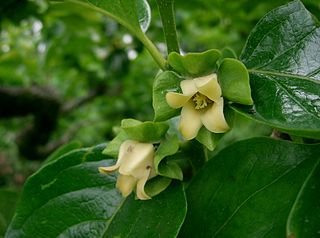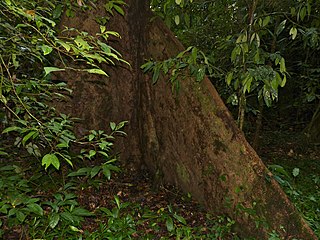
The persimmon is the edible fruit of a number of species of trees in the genus Diospyros. The most widely cultivated of these is the kaki persimmon, Diospyros kaki – Diospyros is in the family Ebenaceae, and a number of non-persimmon species of the genus are grown for ebony timber. In 2019, China produced 75% of the world total of persimmons.

Diospyros is a genus of over 700 species of deciduous and evergreen trees and shrubs. The majority are native to the tropics, with only a few species extending into temperate regions. Individual species valued for their hard, heavy, dark timber, are commonly known as ebony trees, while others are valued for their fruit and known as persimmon trees. Some are useful as ornamentals and many are of local ecological importance. Species of this genus are generally dioecious, with separate male and female plants.

Diospyros mespiliformis, the jackalberry, is a large dioecious evergreen tree found mostly in the savannas of Africa. Jackals are fond of the fruit, hence the common names. It is a member of the family Ebenaceae, and is related to the true ebony and edible persimmon.

Octomeles is a monotypic genus of plant in family Tetramelaceae. The sole species is Octomeles sumatrana, sometimes written O. sumatranum.

Diospyros whyteana is a small African tree of the ebony family. Bearing dark green, strikingly glossy leaves and creamy fragrant flowers, it is increasingly cultivated in Southern African gardens as an attractive and strong ornamental tree. It can attain a height of up to 6 m.
Rauvolfia sumatrana is a tree in the family Apocynaceae.
Diospyros areolata is a tree in the family Ebenaceae. It grows up to 30 metres (100 ft) tall. Twigs are reddish brown when young. Inflorescences usually bear three flowers. The fruits are round, up to 4 cm (2 in) in diameter. The specific epithet areolata is from the Latin meaning "net-like", referring to the leaf veins. Habitat is lowland mixed dipterocarp and swamp forests. D. areolata is found in Peninsular Thailand, Sumatra, Peninsular Malaysia, Java and Borneo.
Diospyros beccarioides is a tree in the family Ebenaceae. It grows up to 20 metres (70 ft) tall. Twigs are reddish brown when young. Inflorescences bear three or more flowers. The fruits are roundish, up to 2.5 cm (1 in) in diameter. The tree is named for its resemblance to Diospyros beccarii, a synonym of Diospyros sumatrana. Habitat is lowland limestone hills from sea level to 200 metres (700 ft) altitude. D. beccarioides is found in Sumatra, Borneo and Sulawesi.
Diospyros cordata is a small tree in the family Ebenaceae. It grows up to 1.5 metres (5 ft) tall. The specific epithet cordata is from the Latin meaning "heart-shaped", referring to the leaf base. D. cordata is endemic to Borneo and known only from Sarawak.
Diospyros coriacea is a tree in the family Ebenaceae. The specific epithet coriacea means "leathery", referring to the leaves. The species is native to Peninsular Malaysia, Singapore and Borneo.
Diospyros foxworthyi is a tree in the family Ebenaceae. It grows up to 20 metres (70 ft) tall. Inflorescences bear up to 15 flowers. The fruits are roundish to oblong, up to 5 cm (2 in) in diameter. The tree is named for the American botanist F. W. Foxworthy. Habitat is lowland mixed dipterocarp forests. D. foxworthyi is found in Peninsular Malaysia and Borneo.
Diospyros keningauensis is a tree in the family Ebenaceae, native to Borneo. It is named for Keningau District in Sabah, a part of its native distribution.

Diospyros maritima is a tree in the family Ebenaceae. The specific epithet maritima means "by the sea", referring to the tree's habitat.
Diospyros ridleyi is a tree in the family Ebenaceae. It grows up to 30 metres (100 ft) tall. Twigs are reddish brown when young. Inflorescences bear up to three flowers. The fruits are round to ovoid, up to 5 cm (2 in) in diameter. The tree is named for the English botanist Henry Nicholas Ridley. Habitat is mainly lowland mixed dipterocarp forests. D. ridleyi is found in India, Peninsular Malaysia and Borneo.
Diospyros rufa is a tree in the family Ebenaceae. It grows up to 30 metres (100 ft) tall. Twigs are reddish when young. Inflorescences bear up to 10 flowers. The fruits are round to ellipsoid, up to 3.5 cm (1 in) in diameter. The specific epithet rufa is from the Latin meaning "reddish", referring to the indumentum of the young twigs. Habitat is lowland mixed dipterocarp forests. D. rufa is found in Peninsular Malaysia and Borneo.
Diospyros singaporensis is a tree in the family Ebenaceae. It grows up to 28 metres (90 ft) tall. Inflorescences bear up to three flowers. The fruits are round, shiny black, up to 3.5 cm (1 in) long. The tree is named after Singapore. Habitat is lowland mixed dipterocarp forests. D. singaporensis is found in Peninsular Malaysia and Borneo.
Diospyros venosa is a tree in the family Ebenaceae. It is native to Southeast Asia, from the Maluku Islands to Myanmar. It provides raw material for handicrafts, traditional medicine and fuel.
Diospyros wallichii is a tree in the family Ebenaceae. It is named for the Danish botanist Nathaniel Wallich.

Diospyros tessellaria is a species of tree in the family Ebenaceae.
Terminalia cambodiana is a species of tree in the family Combretaceae, growing some 6–15 m tall with whitish-grey, exfoliating bark and large greenish branches. It is found in flooded forest communities of Cambodia and southern Vietnam.







